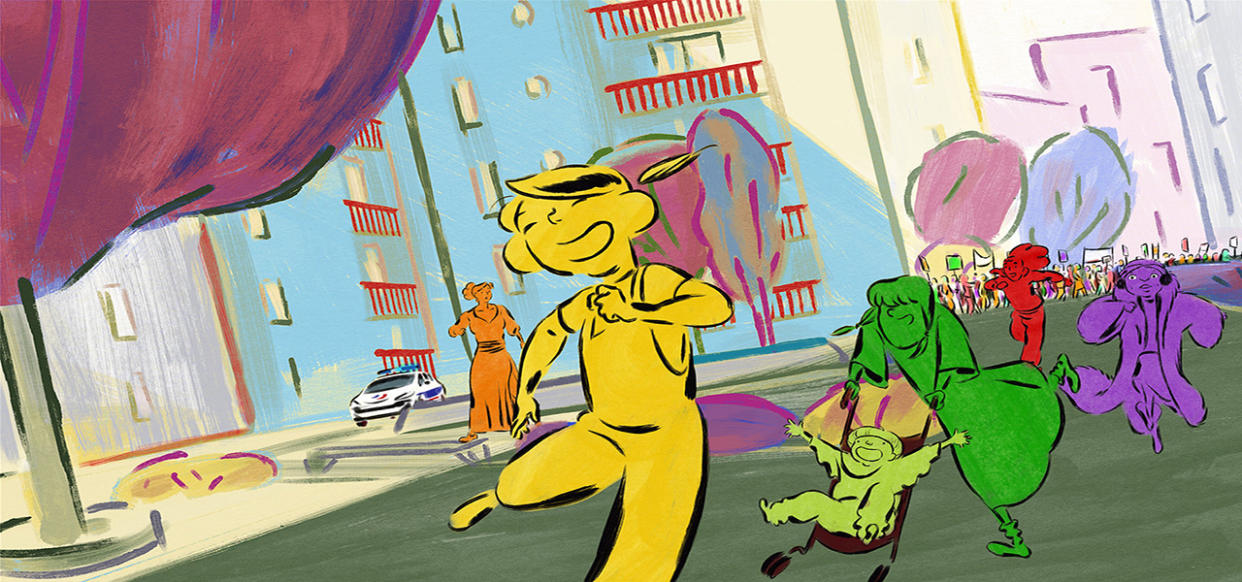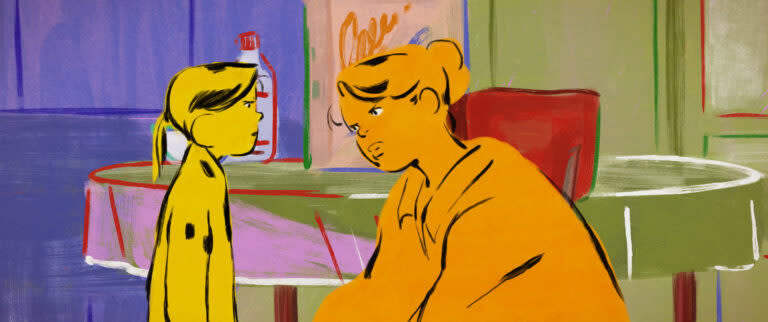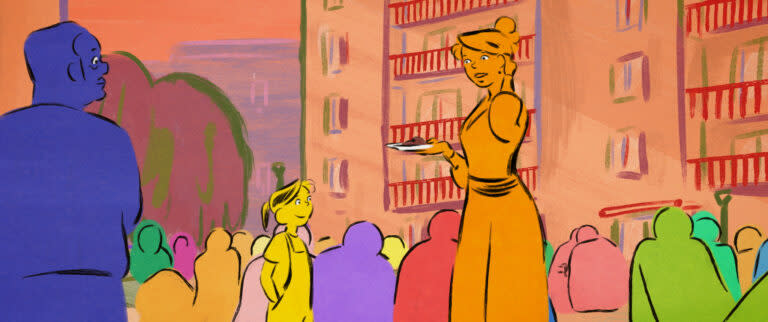The ‘Chicken for Linda’ Recipe Included the French New Wave and ‘All That Jazz’

GKids is definitely back: After winning its first Oscar for Hayao Miyazaki’s “The Boy and the Heron,” the prestigious indie distributor has another animated contender this season with “Chicken for Linda.” The delightful hand-painted French-Italian musical comedy took the 2023 Annecy Cristal Award and the Animation Is Film Grand Jury Prize.
Directed by the married duo Chiara Malta (the live-action “Simple Women”) and Sébastien Laudenbach (the animated “The Girl Without Hands”), the film is about memory and mother-daughter bonding. After Paulette (voiced by Clotilde Hesme) wrongly punishes 8-year-old Linda (Melinée Leclerc), she tries to make it up to her by cooking her late husband’s signature dish: chicken and peppers. It’s the only memory Linda has of her father, who returns as narrator to help fill the void through magical realism. What ensues is a wild chase to catch a chicken during a supermarket strike.
More from IndieWire
The project grew out of a workshop a decade ago, in which Malta wanted to combine memories of food (her grandmother made chicken and peppers) with a French New Wave approach to animation through spontaneity and live sound. She co-wrote the script with her husband, and they boldly advanced the 2D aesthetic he introduced in “The Girl Without Hands” (2016), adding color blotches to black brushstrokes that bleed over the character lines. Only here, the characters are all color-coded: Linda is yellow, Paulette is orange, their cat, Gazza, is purple, and Aunt Astrid (Laetitia Dosch) is pink.
“First, we built a real set in the actual place where the movie would take place, exactly like a live-action movie, except there weren’t cameras,” Malta told IndieWire through an interpreter. “And we recorded the actual sound [with the voice actors] that would come from it. That really fleshed out the movie in a way.”

Laudenbach believes their animation style (achieved by a team of 14 French and Italian artists in Paris) is a modern approach, with its very deliberate series of steps. “For example, the fact that there was only one color per character means we didn’t have to worry about character recognition because the color was doing that job for us,” he told IndieWire. Color helped liberate the monochromatic aspect of each character, as did the live sound.
“We started with yellow for Linda, who is a very sunny character,” Laudenbach continued. “One team took care of the black line, another one of the color, and we asked the colorists to have colors that went outside of the line, so it wouldn’t be well-behaved. We wanted to do a film like a child would do but without their parents watching. We asked a friend, who was a painter, to do the [watercolor] backgrounds, and she has a very sensitive rapport with color.”
The truth conveyed by the unpolished animation lies in its affirmation of pure drawing. Which is why it was important to translate the line, the black silhouette, and the splash of color with precision from drawing to screen. “When you see a line, you don’t ask yourself if it’s real or fake,” he added, “whereas when you see a photo or a film, you might ask yourself what really happened.”
The three musical numbers composed by Clément Ducol, meanwhile, were executed with kaleidoscopic nods to Bob Fosse’s “All That Jazz.” The final one, in fact, about the dashed hopes and dreams of Linda’s dad, is quite emotional.

“We wanted the songs to be part of the narration of the movie, especially because the film is all in the present,” Malta said. “So we wanted opportunities to go into the past and the [interior] of the characters. Also, the father is this mysterious figure and the audience can’t see him, so that moment of song has to be very strong ’cause it’s the only [one] dedicated to him. One of the constant references was ‘All That Jazz,’ a show about death and also life, that is recognizable if you’ve seen it.”
The most challenging sequence for the directors — a tense car ride where Paulette apologizes to Linda at night in the fog, and Linda asks for chicken and peppers — is also their favorite. “It was quite hard,” Laudenbach said. “I had trouble explaining what I wanted because very quickly we arrived at the dissolution of the line, and it is the drawing of the characters that is printed on the fog. The line was exploding and dissolving, but I couldn’t see the fog. It took time [for compositing].”
“There was also the scene when we were leaving the fog and crossing elsewhere,” Malta added. “We had to feel part of the fog and the part where there was no more fog. But the movement was complicated to install. It’s difficult to put into place. I wanted the audience to be disoriented and not know where they were anymore.”
But there was another part of this fog crossing — seeing ghosts in the light — that sums up the essence of the film. “The idea was to make a movie that had magical realism and music but also that was free in the drawing,” Malta continued. “There is the light and this car atmosphere when you’re a child in the back of the car, and it’s a strange moment. And I think it’s something that everybody has experienced. So when you watch the light, it can seem like resuscitating something ghost-like and bringing the dead back to the living. That’s the reason we have this abstract moment with two shots, and we like this sequence for that as well. It’s as if the car was surrounded by ghosts and city lights at the same time.”
“Chicken for Linda,” currently playing theatrically in New York at Angelika Film Center, expands in Los Angeles April 12 at the Laemmle Royal, and select additional theaters April 15 in its original French language.
Best of IndieWire
The 22 Best Spy Movies, from 'Enemy of the State' to 'North by Northwest'
The 12 Best Thrillers Streaming on Netflix in April, from 'Fair Play' to 'Emily the Criminal'
Quentin Tarantino's Favorite Movies: 61 Films the Director Wants You to See
Sign up for Indiewire's Newsletter. For the latest news, follow us on Facebook, Twitter, and Instagram.

 Yahoo News
Yahoo News 
